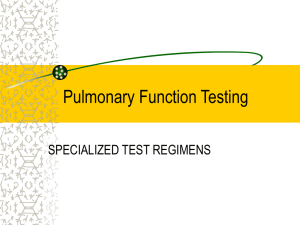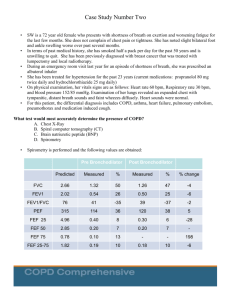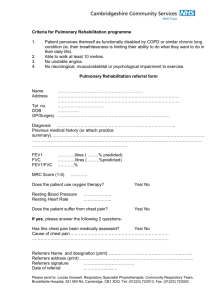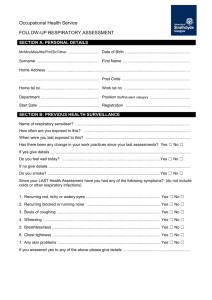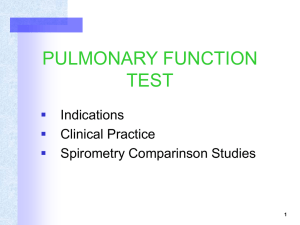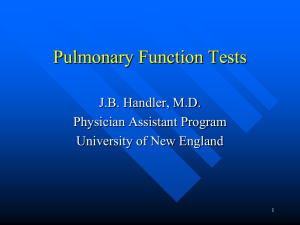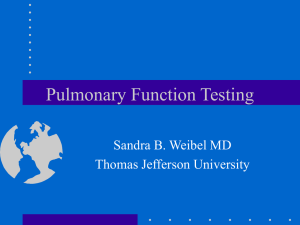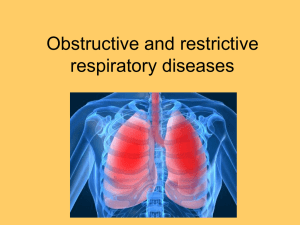Week 9: PFT Interpretation
advertisement
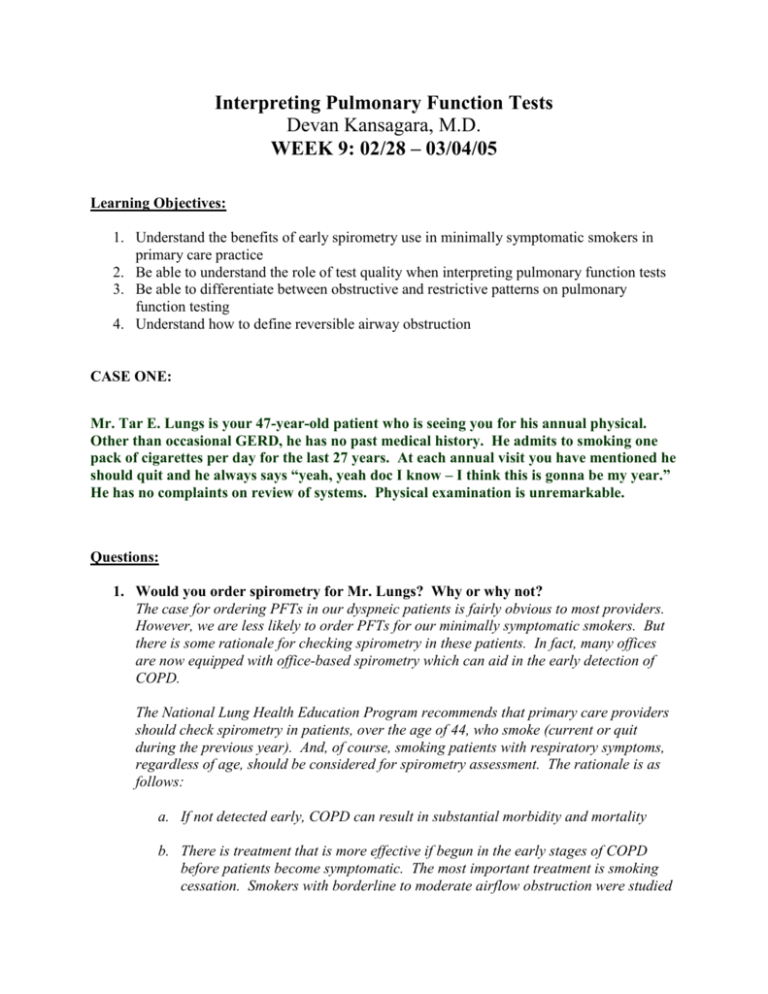
Interpreting Pulmonary Function Tests Devan Kansagara, M.D. WEEK 9: 02/28 – 03/04/05 Learning Objectives: 1. Understand the benefits of early spirometry use in minimally symptomatic smokers in primary care practice 2. Be able to understand the role of test quality when interpreting pulmonary function tests 3. Be able to differentiate between obstructive and restrictive patterns on pulmonary function testing 4. Understand how to define reversible airway obstruction CASE ONE: Mr. Tar E. Lungs is your 47-year-old patient who is seeing you for his annual physical. Other than occasional GERD, he has no past medical history. He admits to smoking one pack of cigarettes per day for the last 27 years. At each annual visit you have mentioned he should quit and he always says “yeah, yeah doc I know – I think this is gonna be my year.” He has no complaints on review of systems. Physical examination is unremarkable. Questions: 1. Would you order spirometry for Mr. Lungs? Why or why not? The case for ordering PFTs in our dyspneic patients is fairly obvious to most providers. However, we are less likely to order PFTs for our minimally symptomatic smokers. But there is some rationale for checking spirometry in these patients. In fact, many offices are now equipped with office-based spirometry which can aid in the early detection of COPD. The National Lung Health Education Program recommends that primary care providers should check spirometry in patients, over the age of 44, who smoke (current or quit during the previous year). And, of course, smoking patients with respiratory symptoms, regardless of age, should be considered for spirometry assessment. The rationale is as follows: a. If not detected early, COPD can result in substantial morbidity and mortality b. There is treatment that is more effective if begun in the early stages of COPD before patients become symptomatic. The most important treatment is smoking cessation. Smokers with borderline to moderate airflow obstruction were studied in the Lung Health Study. Those that were sustained quitters were shown to have a decrease in the rate of decline of lung function (note: on average, nonsmokers lose about 20-30 ml/year in FEV1 as compared to 60 mL/year in “susceptible” smokers). The Lung Health Study also demonstrated that the institution of intense smoking cessation programs can work – 22% had sustained quit rates for five years as compared to 6% in the control group. There is also some evidence that spirometry testing, with results reported to the patient, likely enhances smoking cessation rates. c. There is a feasible testing and follow-up strategy. NHANES III showed that of smokers over 44 years of age without symptoms, 9% of men and 14% of women had evidence of airway obstruction. Regular follow-up testing can show rates of decline of lung function and can aid in determining the success of treatment. 2. Spirometry is performed – what do the following results indicate? Expiratory flow-volume curve FEV1 = 92% predicted Flow L/sec Volume (Liters) The FEV1/FVC ratio (%) is 64 (predicted value, 80%). Spirometry measures the volume exhaled or inhaled as a function of time. For most purposes, we get our important information from having the patient exhale forcefully and fully from a point of maximal inspiration (termed the total lung capacity or TLC) to a point of maximal expiration (the residual volume or RV). The volume of air representing the difference between TLC and RV is the forced vital capacity or FVC. The volume of air exhaled in the first second of the FVC maneuver is the FEV1. The FEV1/FVC ratio gives critical diagnostic information. The American Thoracic Society defines obstructive disease as that in which maximal airflow (FEV1) is disproportionately reduced with respect to the volume of air a patient can exhale from full inspiration to full expiration (FVC). So, patients who have obstructive lung disease have an FEV1/FVC ratio of < 70%. The expiratory flow-volume curve in this patient shows good, robust initial peak, indicating good initial effort. However, the concave shape of the descending part of the curve indicates airflow obstruction. The FEV1/FVC ratio confirms obstructive disease. The relatively preserved FEV1 suggests this is very mild disease. 3. How do you think of test quality when interpreting PFT results? Critical to the interpretation of PFTs is good test quality. Results can vary for the same patient in the same session simply because of variation in patient effort. Results also depend on the standard to which patient results are compared. PFTs use reference values from healthy nonsmokers. If the population studied does not match the reference population, there will be obvious discrepancies. Age, weight, height, race, and gender all affect lung function. For instance, African-Americans have, on average, spirometric values that are 12% lower than Caucasians. So, if using predicted values from a Caucasian reference population, one must multiply the predicted values by .88 for use in African-Americans (as well as those of Asian descent). The ATS has published recommendations on how testing labs should use these standard reference values. PFT results will come with many different variables. If trying to interpret all of the variables, we will invariably come across some “positive” results. It is important to be cautious in interpreting all of the values reported since this can increase the false positive rate of PFTs. For the purposes of most primary care physicians, the FEV1 and FVC will be the two most important variables. Finally, the test itself must be a satisfactory one. There should be full inhalation, evidence of maximal exhalation, no cough, and adequate duration (look for at least a six second test). The test should be repeated during the testing session and the results should be close to one another. In interpreting FVC and FEV1, one should select the largest values for interpretation. The lower limit of normal should be the fifth percentile of the reference population (meaning only five percent of the reference population falls below that value). CASE TWO: Ms. Ikov N. Wiese is a 22-year-old female who comes to you complaining of intermittent chronic dry cough, often brought on by exercise and occurring at night about twice a week. She has heard herself wheeze, especially when caring for Snickers, “that darn hairy cat” that belongs to her neighbor. She has no past medical history. Her family history is remarkable only for atopic dermatitis in her little brother. She does not smoke. She is comfortable with normal vital signs and 99% SaO2 on room air. Physical examination is unremarkable. 4. What would you do and why? a. Give her a provisional diagnosis of asthma and empirically prescribe albuterol prn b. Give her a peak expiratory flow meter (PEF) and ask her to record the values over the next week c. Advise her to accidentally “lose” Snickers the next time she takes care of the cat d. Order PFTs The answer is D. Though the history is obviously very suggestive and we often do treat empirically, there is some rationale for using PFTs in the diagnosis of asthma. The National Asthma Education Program recommends PFTs in the diagnosis and follow-up of all patients with asthma. Patients and physicians may underestimate the severity of airflow obstruction and there is evidence that this may be associated with increased mortality. Once diagnosed, patients can self-monitor with PEF but periodic reassessment of PFTs may be able to show adequacy of treatment. Using PEF itself to diagnose asthma is unreliable. There is more than 30% variability in PEF values in individuals. It is not sensitive enough as the diagnostic procedure of choice. PEF, however, can and should be used to monitor asthma and it should be “calibrated” with the PFT measurements. Answer A should also be recognized as incorrect because, if this is indeed asthma, the patients frequency of nighttime symptoms indicates she has at least mild persistent asthma and would benefit from anti-inflammatory therapy (inhaled corticosteroids). 5. What would you expect to see on PFTs if this were asthma? The hallmark of asthma is reversible airway obstruction. There should be a reduction in FEV1/FVC ratio less than 70%. A bronchodilator should be given and PFTs repeated after ten minutes to assess response. Current ATS recommendations require at least a 12% improvement in FEV1 or FVC to qualify as a significant response. Also, there must be an absolute improvement of 200 mL in the FEV1. Of note, some patients will have no demonstrable obstruction on testing, especially if they have bronchial hyperresponsiveness induced by triggers (cold, exercise etc) not present during testing. Methacholine challenge may be helpful in these settings. The decision, ultimately, to treat the patient with a bronchodilator should rest on clinical grounds. In other words, if PFT testing does not show significant response to bronchodilator therapy, the lack of response does not predict a lack of response from long-term bronchodilator therapy (but they are less likely to respond). In these cases, bronchodilator therapy can be used for 4-6 weeks followed by clinical and spirometric reassessment. CASE THREE: Mr. Krisp E. Cream is a 43-year-old male who comes to the office for evaluation of dyspnea. He has had gradually worsening dyspnea on exertion for many months. He has not had significant peripheral edema or PND, but he does have mild orthopnea. About a year ago he broke off his engagement with his fiancé. He has since become depressed, stopped exercising, and has been “eating just to fill up the time.” He bought a pet bird for companionship. He still works as a welder, but is finding it harder to make it through the day. He has had a normal echocardiogram and stress test, and his chest x-ray looked like it had some hazy opacities in the basal segments, but the radiologist assures you it is just artifact from underexposure related to obesity. He has a respiratory rate of 20. His vital signs are otherwise unremarkable. Room air SaO2 is 96%. He is obese. His BMI is 37 (was 30 one year ago). He has no JVD, lungs are clear, and the rest of the exam is unremarkable. You decide to order PFTs. FVC is 2.7 L (60% predicted). FEV1 is 2.1L (58% predicted). FEV1/FVC ratio is 98%. 6. Do you have a diagnosis based on the PFTs or do you need more information from the PFT lab? The PFTs suggest a restrictive defect (a proportional decrease in both FEV1 and FVC). However, the differential for restrictive defects is large and includes all types of intrinsic lung diseases (e.g. interstitial lung disease or pneumonitis), extrinsic lung disease, and neuromuscular disease. The patient’s history gives potential clues to intrinsic and extrinsic disease. The bird exposure can be a clue to psittacosis or hypersensitivity pneumonitis. A chest CT may be helpful also. A DLCO measurement may be helpful in this case. Intrinsic lung disease should give a low DLCO, while extrinsic lung disease (like obesity) should have a preserved or even high DLCO. If this patient’s DLCO were normal, extrinsic lung disease (i.e. impendence from massive obesity) would be a more likely diagnosis. That said, there is a problem with quality and consistency of reported DLCO values in many PFT labs. With that caveat in mind, however, DLCO can aid in differential diagnosis. Bonus: The following flow-volume loop is from a 28-year-old woman diagnosed with asthma several years ago. She continues to have symptoms of cough and wheezing despite adherence to maximal bronchodilator, corticosteroid, and leukoetriene modifying therapy. 7. What do you think is going on based on the history and flow-volume loop? Would you order any other tests? This patient probably has vocal cord dysfunction, which is increasingly being recognized as a cause of “refractory asthma.” The definitive diagnostic test would be laryngoscopy. The flow-volume loop shows variable extrathoracic airway obstruction. The forced inspiratory maneuver shows a characteristic flow limitation during inspiration (flattening of the inspiratory part of the loop) but essentially normal expiration. References: 1. Evans SE and Scanlon PD. Current practice in pulmonary function testing. Mayo Clin Proc. 2003; 78:758-763. 2. Crapo RO. Pulmonary-function testing. N Engl J Med. 1994; 331:25-30.
